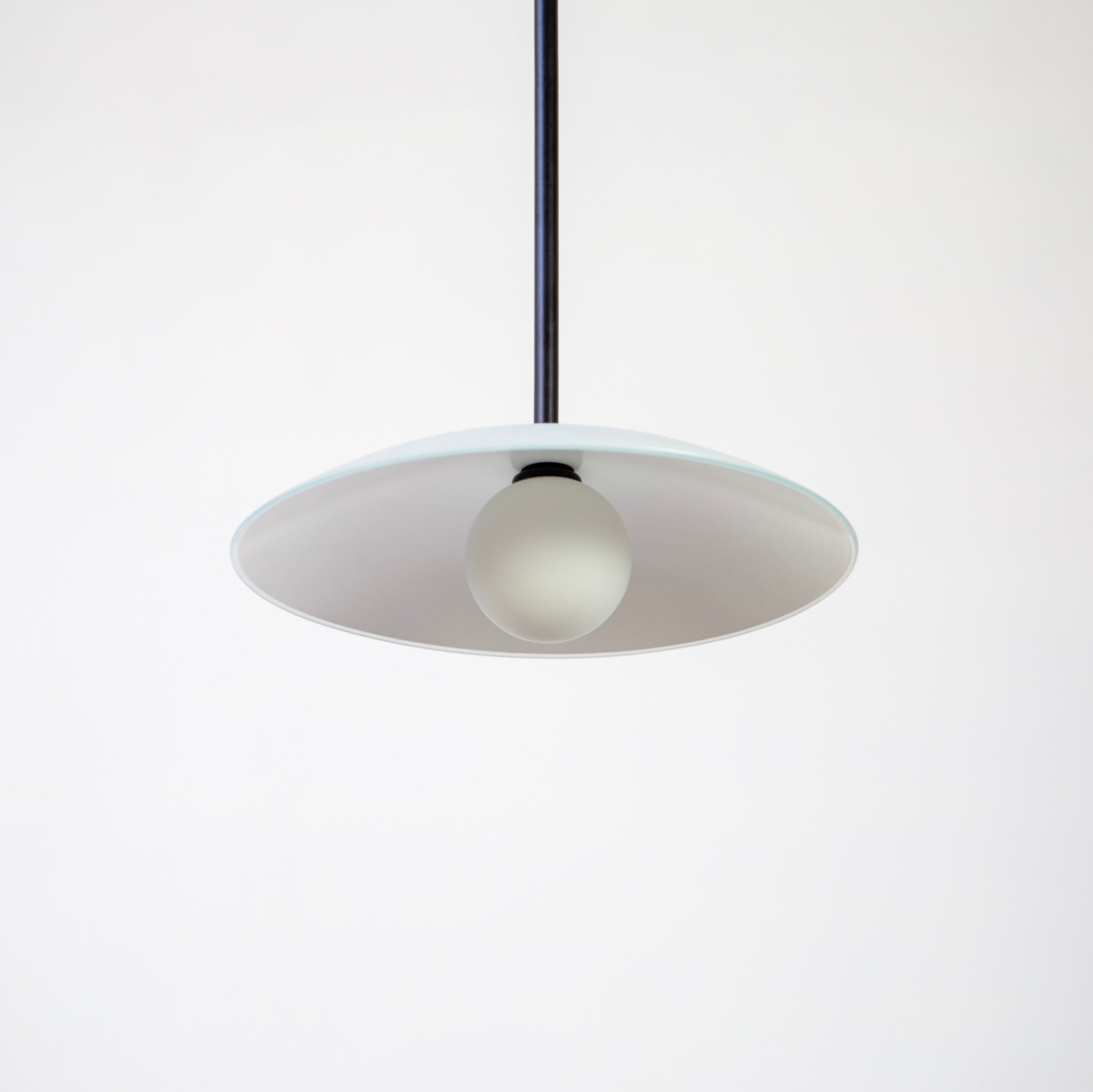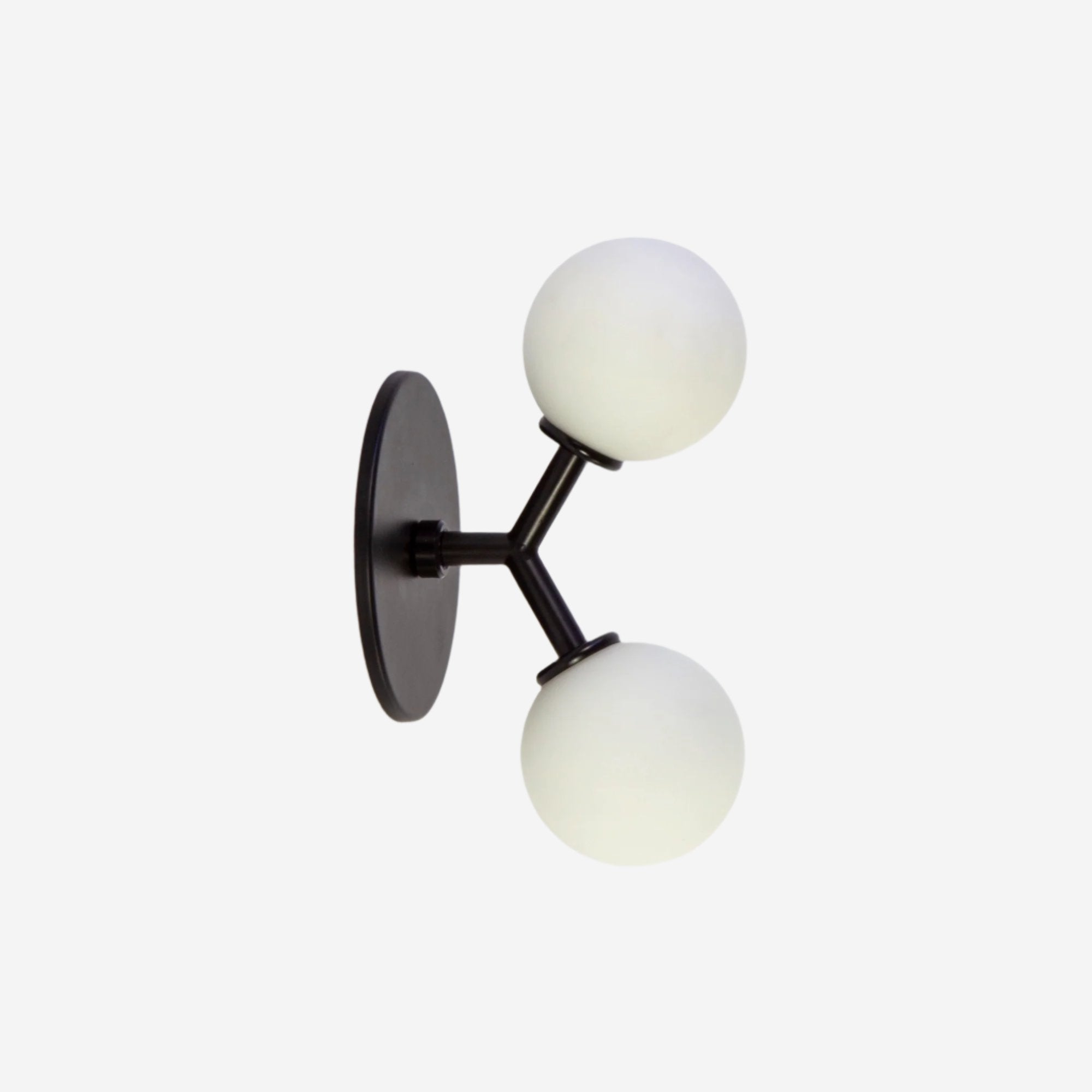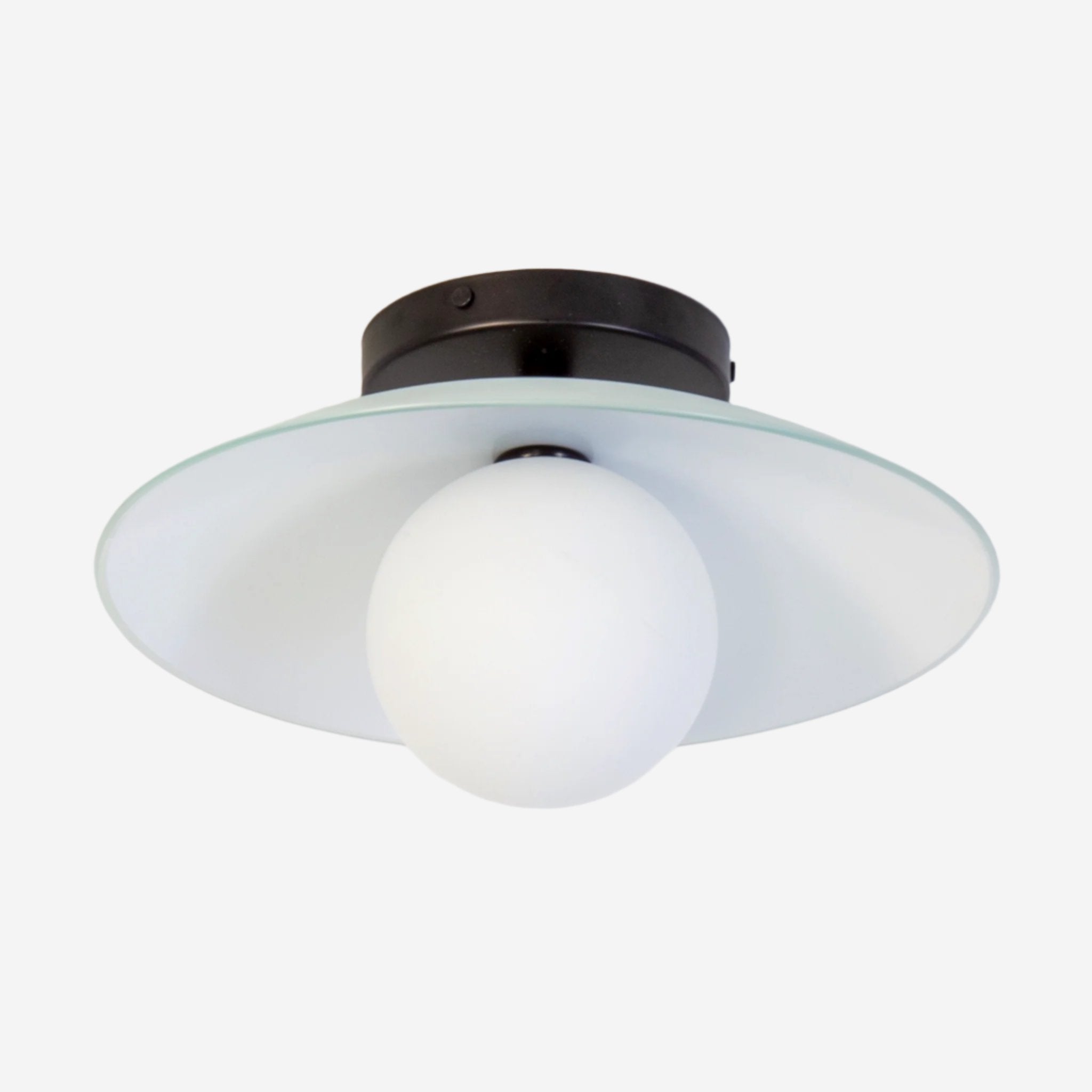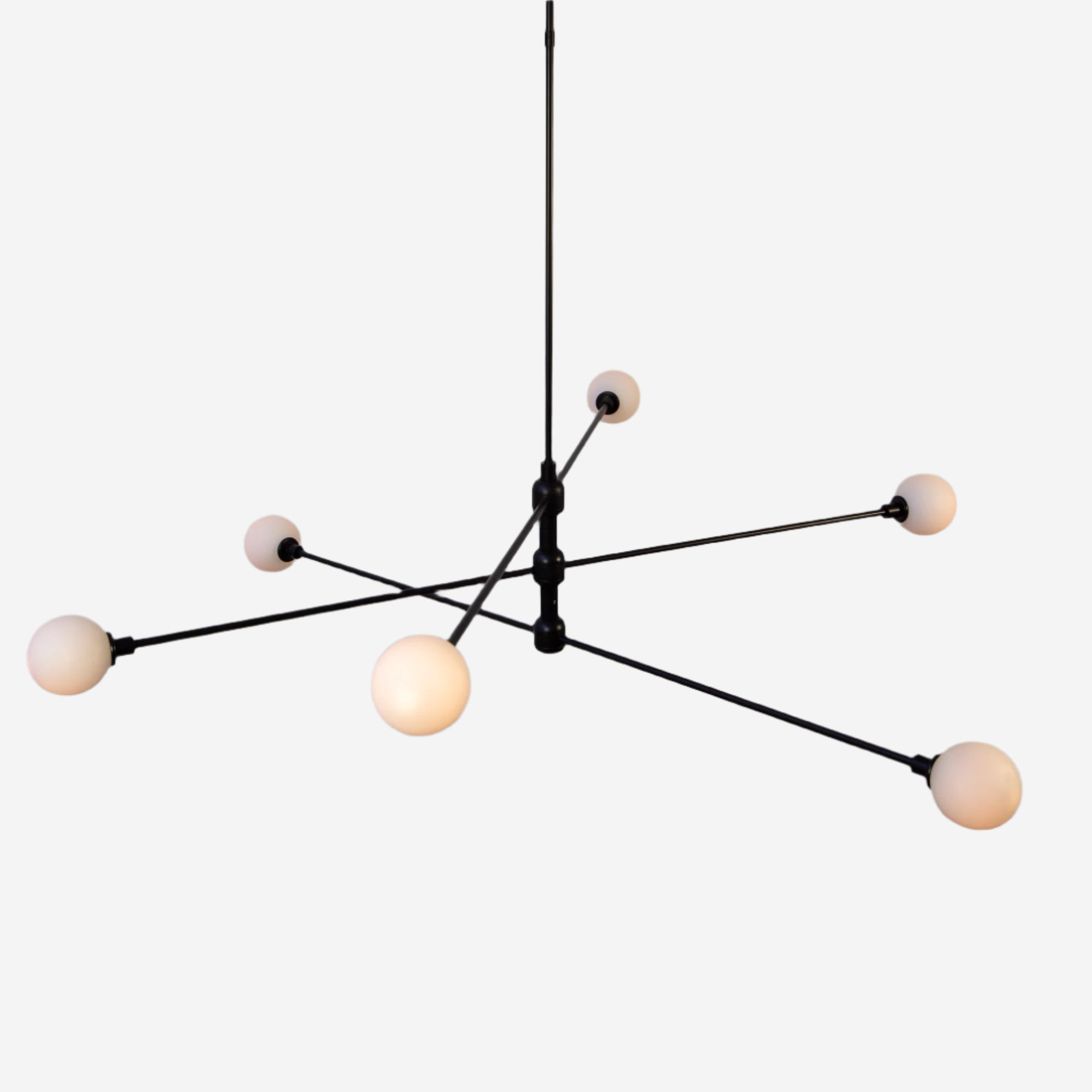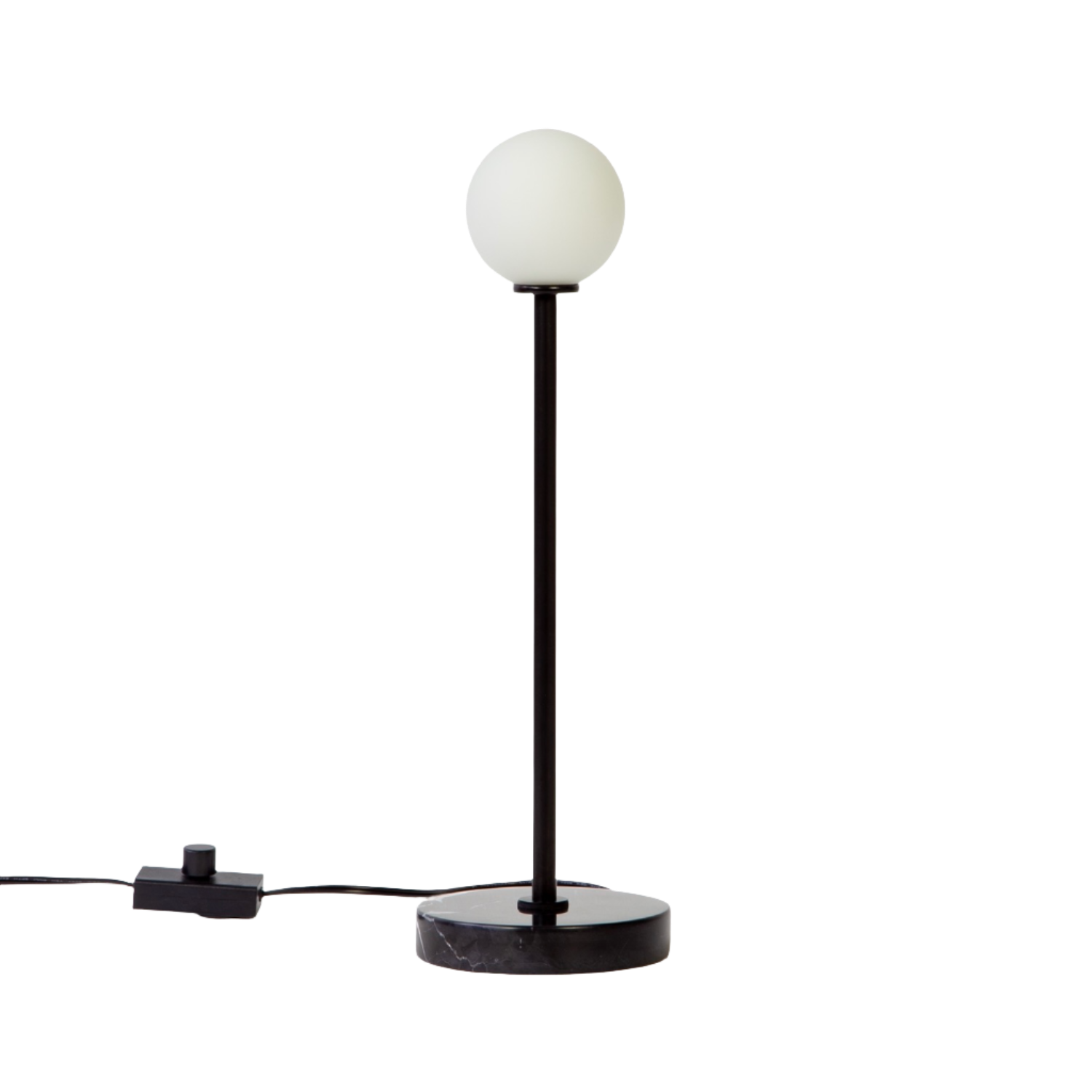
Glossary of Lighting Terminology
Modern lighting has its own language. Some words are familiar, others feel like they were invented in a lab. This glossary keeps it simple: the terms you’ll actually run into when choosing a pendant, sconce, flush mount, chandelier, table lamp, or floor lamp - and some terms you may hear an architect say while you nod your head (not knowing what they mean). Think of it as a quick reference, a way to decode the details without slipping into engineer-speak. Because light should be clear, and so should the words around it.
Accent Lighting
Focused light used to highlight an object, detail, or surface.
Adaptation
How eyes adjust to brighter or darker conditions after a change in light.
Ambient Lighting
General illumination that fills a room evenly.
ANSI (American National Standards Institute)
Sets voluntary standards and guidelines used across electrical and lighting industries.
Arc Tube
The sealed tube in a discharge lamp where the arc forms and light is produced.
Arm
The part of a fixture that holds the bulb or shade away from its base.
Arm Sconce
A wall sconce with an extended arm that projects light outward.
Armature
The supporting structure of a light fixture.
Average Life
Estimated operating hours at which half of a group of lamps have failed.
Backplate
The plate that attaches a wall sconce to the wall and covers the junction box.
Baffle
A shield that blocks direct view of a light source or absorbs stray light.
Ballast
Electronics that start and regulate fluorescent or HID lamps.
Ballast Factor
How much light a ballast produces with a given lamp compared to a reference ballast.
Base
The end of a lamp that fits into the socket.
Beam Angle
The width of the light beam, measured between points at 50 percent of peak intensity.
Beam Spread
The angle where output falls to a stated percent, often 10 percent, of maximum.
Blown Glass
Glass formed by hand blowing. Natural variation is expected. Used to make glass pendant lights, glass sconces, glass flush mount ceiling lights, glass chandeliers, glass table lamps, etc.
Brightness
See Luminance or check out our Lumens to Watts Conversion Chart & Brightness Comparison
Bulb
The outer envelope of a lamp. Often used casually to mean the whole lamp.
Burning Position
The orientation a lamp is designed to operate in.
Candela (cd)
Unit of luminous intensity in a given direction.
Candlepower Distribution
A curve showing how intensity changes by direction for a lamp or luminaire.
Canopy
The cover that attaches a fixture to the ceiling or wall and hides wiring.
CCT (Correlated Color Temperature)
The appearance of light from warm to cool, measured in Kelvins.
Center Beam Candlepower (CBCP)
Intensity at the center of a directional beam, in candelas.
Chromaticity
The qualities of color, including dominant wavelength and purity.
Chandelier
A chandelier is a ceiling fixture with multiple bulbs or arms that provides ambient light and visual structure. It's generally larger than a pendant light.
Cluster Chandelier / Cluster Fixture / Cluster Light
A fixture with several pendant lights grouped close together, often at varied heights. When the grouping is larger, it moves into chandelier territory.
Coefficient of Utilization (CU)
How much of a luminaire’s light reaches the work plane.
Color Rendering Index (CRI)
How accurately a light source reveals color on a 0 to 100 scale.
Color Temperature
Warmth or coolness of light, measured in Kelvins. For more info, read our guide to understanding color temperature.
Cone Sconce
A double sconce using opposing cones and globes, often around mirrors.
Cord Suspension
A pendant or chandelier hung from a cord instead of a rigid rod.
Cove Lighting
Concealed lights near ceilings or ledges that provide indirect ambient light.
CRI
See Color Rendering Index.
Cutoff Angle
Angle at which shielding hides the light source from view.
Desk Lamp
A Desk Lamp is a portable task light for a work surface.
Diffuse Lighting
Light that arrives from many directions with soft shadows.
Diffused Glow
Light softened to reduce glare and hard edges.
Diffuser
Material or component that scatters light for softer output.
Diffuser Lens
Glass or acrylic panel that spreads LED light evenly.
Direct Glare
Glare from bright, unshielded sources in the field of view.
Direct Lighting
Most of the light is directed downward to the task or floor.
Directional Lighting
Light aimed from a single predominant direction.
Disability Glare
Glare that reduces visibility or performance.
Discharge Lamp
Lamp that produces light from an electric arc rather than a filament.
Discomfort Glare
Glare that is annoying or uncomfortable but may not reduce performance.
Double Sconce
A double sconce is a wall lamp with two light sources.
Double-Ended Lamp
Lamp with two bases on opposite ends.
Downlight
Light directed downward, typically from a ceiling or recessed source.
Downstem / Downrod
Rigid rod connecting a hanging fixture to its canopy.
E12 Socket
Small candelabra screw base common in chandeliers.
E26 Socket
Standard medium screw base used in many U.S. fixtures.
Edison Bulb
Decorative bulb with visible filaments.
Efficacy
Lumens per watt, a measure of efficiency.
Energy (kWh)
Electrical energy used over time, measured in kilowatt-hours.
Filament
Wire in an incandescent lamp that glows when heated.
Finish
The surface treatment on metal or glass, such as powder coating or plating.
Floodlight
Directional lamp with a wider beam than a spotlight.
Flush Mount
A short ceiling light with an exposed body.
Fluorescent Lamp
Low-pressure discharge lamp with phosphor coating that converts UV to visible light.
Floor Lamp
Freestanding lamp placed on the floor for ambient or task light.
Footcandle (fc)
Illuminance of one lumen per square foot.
Frosted Glass
Matte glass that diffuses light. Research.Lighting makes a number of glass light fixtures that use frosted glass.
Frequency (Hz)
How often AC current cycles each second.
General Lighting
See Ambient Lighting.
Glare
Excessive brightness that causes discomfort or reduces visibility.
G8 Bulb
Compact pin-base bulb used in tight fixtures.
G9 Bulb
Compact pin-base bulb common in modern sconces and pendants.
Halogen Bulb
Incandescent type with brighter, whiter light.
Hard Light
Strong, directional light that creates sharp shadows.
Hardwire
Permanant electrical connection to a wall or ceiling box.
Hardwired Fixture
Fixture connected directly to building wiring.
Hertz (Hz)
Unit of frequency. See Frequency.
HID (High Intensity Discharge) Lamp
Family of discharge lamps including metal halide and high-pressure sodium.
Illuminance
Light arriving on a surface, measured in footcandles or lux.
Incandescent Bulb
Traditional bulb with a glowing filament, warm light, lower efficiency.
Indirect Lighting
Most of the light is directed upward and reflected into the room.
Infrared Radiation (IR)
Radiation just beyond visible red, present in some light sources.
Initial Lumens
Output measured after a short burn-in period, before depreciation.
Integrated LED
LEDs built into the fixture rather than replaceable bulbs.
Joule
Unit of energy. One watt-second.
Kelvin (K)
Unit for color temperature.
Lamp
Manufactured light source. Casual use may mean bulb.
Lamp Life
Average hours until 50 percent of a lamp group has failed.
Lens
Glass or plastic element that shapes or directs light.
LED (Light Emitting Diode)
Efficient, long-life light source.
Light Center Length (LCL)
Distance from lamp base to the light center.
Light Loss Factor (LLF)
Adjustment for real-world conditions like dirt, temperature, and lamp aging.
Linear Chandelier / Linear Fixture / Linear Pendant
Chandelier or pendant light arranged in a single horizontal line, commonly used over counters or tables.
Line Voltage
Standard household power, 120 V in the U.S.
Louver
Array of baffles that hide the source or control glare.
Lumen (lm)
Unit of luminous flux, the amount of light emitted. Read our guide to understanding lumens for more info.
Lumen Depreciation
Reduction of light output over time.
Lumen Maintenance
Percentage of initial lumens a source still produces at a point in its life.
Luminaire
The complete lighting unit: housing, optics, lamp or LED, and wiring.
Luminaire Efficiency
Ratio of light leaving the luminaire to light produced by the lamp or LED.
Luminance
Light reflected or emitted in a specific direction, related to perceived brightness.
Luminance Contrast
Difference in luminance between an object and its background.
Luminance Ratio
Ratio between any two luminances in the field of view.
Luminous Flux
Total light output, measured in lumens.
Lux (lx)
Illuminance of one lumen per square meter.
Machined Metal
Metal shaped with precision cutting tools.
Matte Surface
Non-glossy surface that scatters reflected light.
Mean Lumens
Output measured at a defined midpoint of lamp life.
Millicandela (mcd)
One-thousandth of a candela, used for small LEDs.
Mounting Plate
Hardware that secures a fixture to the wall or ceiling.
Nanometer (nm)
Unit of wavelength. Used to describe color and spectra.
Non-Shunted Socket
Contacts are isolated so current follows separate paths. Used with certain retrofits.
Patina
Natural or applied surface change on metal.
Pendant Light
Pendant Lights are fixtures suspended by cord, rod, or chain. Generally smaller than a Chandelier.
We have a FAQs about Pendant Lights page if you wanna dive deeper.
Plating
Thin metal layer applied for color and finish.
Plug-In Light
Fixture powered by a cord and outlet.
Powder Coating
Durable baked-on finish for metal parts.
Power (W)
Rate of energy use, measured in watts.
Power Factor
How effectively a device converts volt-amperes into watts.
Reading Light
Directional light sized for books and small tasks.
Recessed Lighting
Ceiling lighting with no exposed body where only the aperture shows.
Reflectance
Percent of light a surface reflects.
Reflected Glare
Glare from bright reflections in glossy surfaces.
Reflection
Light bouncing off a surface.
Reflector
Surface that redirects light by reflection.
Refraction
Change in light direction as it passes between materials.
Refractor
Optic that redirects light primarily by refraction.
Resistance (Ω)
Opposition to electrical current.
Restrike Time
Time for a hot discharge lamp to re-light after power is restored.
Sconce
A light fixture that mounts to the wall. For an unnecessarily detailed explanation, see Wall Sconce Meaning: What is a Sconce?
Shade
Part that diffuses or directs light.
Shade Holder
Component that secures a shade to a fixture.
Semi-Flush Mount
Ceiling light mounted close to the surface with a short slight drop.
Shielding
Methods and parts used to block, redirect, or soften light.
Shielding Angle
Angle that describes how a luminaire hides its source from view.
Shroud
Glass cylinder around a discharge lamp’s arc tube for containment.
Shunted Socket
Contacts are internally connected so current shares a path.
Socket
Where the bulb or lamp connects to the fixture electrically and mechanically.
Soft Light
Diffused illumination with minimal shadows.
Spectral Power Distribution (SPD)
Graph showing a source’s output at each wavelength.
Specular Surface
Glossy surface that reflects light like a mirror.
Spun Metal
Metal formed by spinning a disc over a mold to create smooth curves.
Stamped Metal
Metal formed by pressing into a die for crisp shapes.
Spotlight
Directional lamp with a narrow beam for tight aiming.
Stem
Rigid piece connecting a fixture body to its suspension.
Surface Mount Light
Fixture mounted directly to a surface rather than recessed. For more info, read: What is a Surface Mount Light Fixture?
Supplementary Lighting
Additional light used to support general lighting for specific tasks.
Suspension Light
Any fixture that hangs from the ceiling.
Swing Arm Sconce
Wall sconce with a movable arm for adjustable reach.
Table Lamp
A table lamp is a portable lamp meant to rest on a desk, sideboard, or another elevated horizontal surface.
Task Lighting
Light aimed at specific activities.
Tiered Chandelier
Chandelier arranged in stacked levels.
Transformer
Device that converts line voltage to low voltage.
Transmission
Light passing through a material.
Transmittance
Ratio of transmitted light to incident light through a material.
Uplight
Light aimed upward to wash ceilings.
Ultraviolet Radiation (UV)
Radiation just beyond visible violet. Some sources emit small amounts.
Veiling Reflections
Reflections that reduce contrast and obscure detail.
Visual Comfort Probability (VCP)
Predicts how many observers are likely to find a lighting setup comfortable.
Visual Field
Everything visible when the head and eyes are fixed.
Visual Surround
All areas in the visual field except the visual task.
Visual Task
The detail or object that needs to be seen to perform an activity.
Voltage (V)
Electrical potential difference, in volts.
Warm-Up Time
Time for a discharge lamp to reach near full output.
Watt (W)
Unit of electrical power.
Work Plane
The plane where tasks occur and illuminance is measured, typically 30 inches above the floor.
